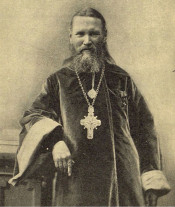
“Boundless, forgiving kindness was expressed in his face” – St. John of Kronstadt in the memoirs of his contemporaries
“He remains the same - polite, gentle and friendly anywhere, - a wonderful and amazing person! It is not enough to love such a person - you revere him!” – this is what one of the parishioners once said about St. John of Kronstadt. The 189th anniversary of the birth of St. John of Kronstadt will be marked on October 19, 2018 (on October 31, according to the new style).
The portal of the Presidential Library provides access to a wide variety of materials, which shed light on the life and deeds of one of the most revered saints in Russia: his diary, discourses and teachings as part of the complete collection of works, Father John’s reply to Leo Tolstoy’s Appeal to the Clergy, to name just a few. Of particular interest are memories of contemporaries, which portray the priest.
“Memoir of Father John” (1909), written by one of the parishioners, describes the way she made the acquaintance with Father John, who was famous across Russia at that time: “At the mass he was dressed in a blue brocade vestment and held the service in the Cathedral with other priests, who wore gold brocade robes. He stood out dressed in his azure vestments with the remarkable air of dignity. I was astonished by the expression of boundless kindness of his face. Boundless, forgiving kindness was expressed in his face. It was just heavy gait, as if stiff, that betrayed his old age”.
Contemporaries compared the appearance of the priest with that of a true Christian pastor, but most of all they were amazed by his speech, which touched the inner soul: “The voice - second tenor – is pure and sonorous. Pronunciation is articulate, distinct, and brisk. One word he would utter in a tongue-twister manner, another he would drawl, almost breaking it into syllables. He gets carried away by reading and can’t help gesturing expressively. – the diary of the village priest John Popov reads.
Father John devoted his whole life to people: he supported charities, founded a workhouse with workshops, a school for the poor, a poorhouse for women, and an orphanage. V. P. Sokolov’s “Father John Ilyich Sergiyev of Kronstadt” (1908) reads: the future priest grew up in severe poverty, “he saw the scenes of extreme poverty, almost hunger. Only depressing pictures of human life, grief and despair remained in the soul of the child. He was not aware of a different, carefree life. This all encouraged love for people and compassion for human grief and unhappiness”.
The priest in Kronstadt was known not only for his good deeds, but also for the gift of miraculous healing: he could cure the sick, whom even doctors were unable to treat. Numerous accounts are collected in Ivan Loginov’s book entitled “Father John Ilyich Sergiyev of Kronstadt Archpriest of St. Andrew’s Cathedral” (1891). What is more, Father John had the power of distance healing. Ye. V. Dukhonina’s memoir reads: “My 12 year old nephew was sick: measles was complicated by pneumonia; doctors said he was going to die any moment. I sent a telegram to father John, asking him to pray, and before the answer came, the boy had fallen asleep peacefully. His face revived, the deadly pallor disappeared, the doctor who attended him, was amazed and told me: look, there are signs that the situation is improving, he might get better, indeed. Then we sent a telegram to the father John, which read: God is merciful – he will send the recovery. And from that moment the recovery began”.
John of Kronstadt died on January 2, 1909 at the age of 79, but people didn’t stop coming to his tomb. The publication entitled “The Miraculous Power of Father John’s Prayers” reads that though five years had passed since the death of Father John, people still visited his holy tomb every day - both those, who knew him and new countless pilgrims from all corners of our country, and even foreigners.
John of Kronstadt was canonized by the Russian Orthodox Church in 1990.
But it is not just individual works, which give an insight into the life and deeds of the saint, that the Presidential Library portal presents. The electronic collection “Kronstadt – The City of Russian Naval Glory” features rare publications, dedicated to St. Andrew’s Cathedral, where Father John had held services, which has not survived to this day. Archival materials about the history of construction of the Naval Cathedral – the main cathedral of the Russian Navy, are also freely available. By the way, it was John of Kronstadt, who called for its construction.

